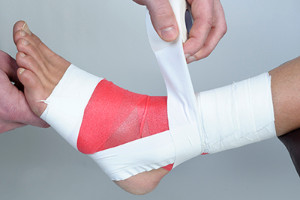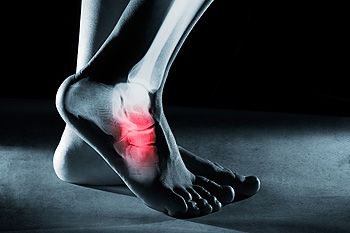 Ankle pain can occur for a variety of reasons. A large percentage of ankle pain often includes ankle sprains, and this typically happens if the ankle rolls inwards. This can occur as a result of stepping off of a curb unexpectedly, which can cause the ligaments to overstretch and tear. The symptoms of an ankle sprain that many patients experience can include bruising on and around the affected site, swelling and tenderness, and it may even be difficult to walk. When treatment is started, it is important to keep the weight off of the foot as much as possible. This can be accomplished by using crutches, and frequently elevating the foot. Support may be found when an elastic bandage is wrapped around the ankle, or a brace may also be used. An ankle sprain is one form of ankle pain. If you have ankle pain for any reason, it is suggested to speak to a podiatrist who can offer the best treatment options.
Ankle pain can occur for a variety of reasons. A large percentage of ankle pain often includes ankle sprains, and this typically happens if the ankle rolls inwards. This can occur as a result of stepping off of a curb unexpectedly, which can cause the ligaments to overstretch and tear. The symptoms of an ankle sprain that many patients experience can include bruising on and around the affected site, swelling and tenderness, and it may even be difficult to walk. When treatment is started, it is important to keep the weight off of the foot as much as possible. This can be accomplished by using crutches, and frequently elevating the foot. Support may be found when an elastic bandage is wrapped around the ankle, or a brace may also be used. An ankle sprain is one form of ankle pain. If you have ankle pain for any reason, it is suggested to speak to a podiatrist who can offer the best treatment options.
Ankle pain can have many different causes and the pain may potentially be serious. If you have ankle pain, consult with one of our podiatrists from Westside Podiatry Center, LLP. Our doctors will assess your condition and provide you with quality foot and ankle treatment.
Ankle pain is any condition that causes pain in the ankle. Due to the fact that the ankle consists of tendons, muscles, bones, and ligaments, ankle pain can come from a number of different conditions.
Causes
The most common causes of ankle pain include:
- Types of arthritis (rheumatoid, osteoarthritis, and gout)
- Ankle sprains
- Broken ankles
- Achilles tendinitis
- Achilles tendon rupture
- Stress fractures
- Tarsal tunnel syndrome
- Plantar fasciitis
Symptoms
Symptoms of ankle injury vary based upon the condition. Pain may include general pain and discomfort, swelling, aching, redness, bruising, burning or stabbing sensations, and/or loss of sensation.
Diagnosis
Due to the wide variety of potential causes of ankle pain, podiatrists will utilize a number of different methods to properly diagnose ankle pain. This can include asking for personal and family medical histories and of any recent injuries. Further diagnosis may include sensation tests, a physical examination, and potentially x-rays or other imaging tests.
Treatment
Just as the range of causes varies widely, so do treatments. Some more common treatments are rest, ice packs, keeping pressure off the foot, orthotics and braces, medication for inflammation and pain, and surgery.
If you have any questions, please feel free to contact one of our offices located in Liverpool, Camillus, Skaneateles, Oswego, and Cicero, NY . We offer the newest diagnostic and treatment technologies for all your foot care needs.





